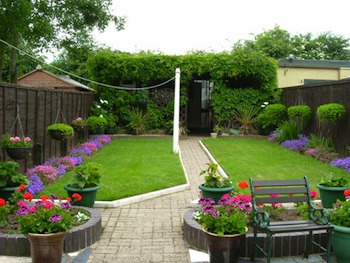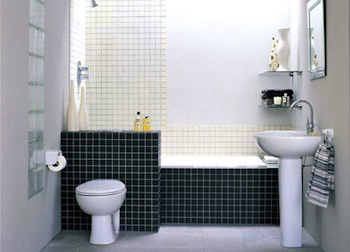Conserve water
Water conservation in the home
In light of the fact that the world is running out of water it is essential that we all play our part in trying to conserve water. In order to help you do so we have put together some useful tips on how to conserve water in different parts of the home that can be accessed through the links below:
Bathroom

The bathroom is probably the room in the house that uses the most water. Below are some tips on how to save water in the bathroom - and most of them are cost-free!
Toilet:
- The average toilet can use 9 - 14 litres of water per flush so only flush where necessary - for e.g. there is no need to flush the toilet if you throw a tissue in the bowl.
- Make sure your toilet cistern is not leaking - a leaking cistern can waste 16,000 litres of water a year.
- Install a dual-flush system or place a water saving device in the toilet cistern, but ensure that your toilet is suitable for a water saving device before installing one. 'Hippo' the Water Saver is a simple and proven water saving device to help conserve water in toilet cisterns. Every time a toilet is flushed the Hippo saves up to 3.5 litres of water. See the Hippo the water saver site for information.
- Using the half flush on a toilet, where appropriate, can save a four-person family more than 36,000 litres of water a year.
- If installing a dual flush is not an option for you, then, using a 2-litre bottle, remove all labelling and fill it with water. Place this in the cistern of your toilet. This means that you will be saving 2 litres of water every time you flush the toilet.
- It is essential that you take care with what you flush down the toilet. Please see NI Waters Bag It and Bin It Campaign for more information.
Note:If you find that you need to flush the toilet a second time to get rid of waste then ensure that your toilet cistern’s capacity is not less than 6 litres and replace the bottle with a smaller one.
Hippo Bag Instructions:

Hippo bags are a simple and proven water saving device to help conserve water in toilet cisterns. Installing a Hippo couldn’t be easier and will save up to three litres of water per flush. Simply place the device in the water underneath your cistern float. When the toilet is flushed, the water confined within the Hippo’s polyethylene bag is saved. Hippo bags should only be used in toilet cisterns with a 9 litre flush or greater (usually pre-1993). If you have a toilet cistern with a 7-9 litre flush (usually installed 1993-1999), you should use a Save-a-Flush bag. These typically save 1 litre per flush. Dual flush and slimline toilets are already water efficient and do not need any type of cistern device.
Sinks:
- When washing your hands and face put the plug in the sink as this uses less water than a running tap. Use a glass when brushing your teeth.
- Do not leave the tap running when brushing your teeth or shaving! A running tap will dispense 6 litres a minute.
- Fix leaking taps (a leak of just one drop per second can waste 10, 000 litres of water a year!)
Showers:
- Take a shower instead of a bath - a bath uses as much as 80 litres whereas a shower can use as little as 30 litres. This will also reduce your energy bill as you heat less water.
- Avoid power showers, which can easily use between 8 and 15 litres of water a minute, so a 5 minute shower can use just as much water as a bath. Some power-showers can use up to 125 litres in less than five minutes!
- Install a water efficient/water saving shower head, or put a restricting washer in it to reduce the water flow.
- Take shorter showers. Not only do showers use up a huge amount of water, water heating is the biggest single contributor to greenhouse gas emissions in the home.
Baths:
- The average bath uses as much as 80 litres of water. Why not take a shower instead? A five-minute shower can use half the water of an average bath but be aware of power showers! They can use a third more water than the average bath (125 litres in less than 5 minutes). This will also reduce your energy bill as you heat less water.
- Bathe children together.
- If you do take a bath, don’t wait for the hot water to come - put the plug in right away.
Kitchen

- Store drinking water in the fridge instead of running the tap when you want a drink of cold water.
- Do not use running water to thaw meat or other frozen foods. Defrost food overnight in the fridge or by using the defrost setting on your microwave.
- Automatic dishwashers claim the most water in kitchens, about 14 gallons per load. Try hand washing dishes as much as possible - if you do this make sure that you don’t leave the water running for rinsing. If you have two sinks use one for soapy water and one for the water you need for rinsing. If you have only one sink, gather washed dishes in a dish rack and rinse them with a sprayer or a pan full of hot water.
- If using a dishwasher, wait until it is full before starting it as it will use the same amount of water whether it is full or half empty.
- Don't rinse plates before putting them in the dishwasher - that’s what the dishwasher is for!
- If you are hoping to buy a new (or your first) dishwasher make sure you look for an water efficient one - some dishwashers are now designed with a water-saver function.
- Changing your cooking habits can also have an impact - instead of boiling you could try steaming. Not only does steaming use a lot less water, it also retains far more nutrients in your food and that can only be good for you.
- Dry brushing and spot cleaning the floor. Sweep up the scraps regularly and spot mop spills rather than washing the whole floor each time. Leave that to the weekly mopping instead.
- Only fill the kettle with the amount of water you need - if you’re only making one cup of tea or coffee, don't fill it to full capacity.
- Use water from your dishes to water your plants; the soapy water will keep the green fly away!
- A dripping tap can waste up to 30 litres of water per day; fix all drips and leaks that you come across ASAP!
Outdoors

Here are some tips on how to save water outdoors:
- Collect rainwater from your roof and pipes in a water butt or buckets and use it to wash your car and water your plants. Rainwater is more natural than piped water to use for watering your plants.
- Washing your car with a hose typically uses 300 litres, which is equivalent to 33 buckets of water.
- If you must wash your car, use a bucket and sponge and wash it on the lawn! You may as well water the lawn at the same time. Even better, wash your car in the rain! This can be fun for the kids too.
- Mulch around garden plants to conserve moisture and reduce the need for watering.
- Before watering your plants check the weather forecast - it may rain tonight or tomorrow!
- Water in the evening to reduce the amount of water that may evaporate.
- Watering gardens and hanging baskets from a hand-held watering vessel uses much less water than a hose. Reusing suitable water from other household activities will save even more.
- A sprinkler uses more water in one hour than a family of four uses in a day. Use a watering can instead of a sprinkler.
- Avoid the use of paddling pools and if you do use them, reuse the water in your garden.
- Avoid using your hose to wash down your driveway or patio. Sweep up leaves instead. If you must wash the drive, use a bucket or even better, do it when it’s raining!
- Know how to turn off your water supply. This could save thousands of litres of water and damage to your home in the event of a pipe burst.
- Phone and report water leakage from burst pipes to your local council.
- More plants die from over watering than under watering. Only water plants when necessary.
- Place ice cubes under the soil in hanging baskets, planters and pots to give your plants cool water and eliminate an overflow of water.




